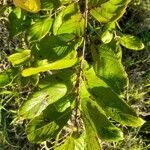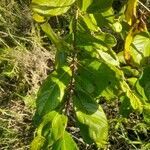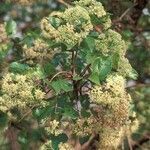Small tree or shrub, 1.8-5.0 m high. Young stems glabrous to tomentose. Leaves elliptic, elliptic-oblong, ovate, obovate or almost round, glabrous to densely pubescent or velvety. Inflorescence dense, branched, terminal, corymbose panicles. Capsule ellipsoid or globose, crustaceous, 6-10 mm long. Flowers creamy white or pale yellow, tube tinged pink.
Leaf blades 1.5–13.5 × 1.2–7.5 cm, elliptic, elliptic-oblong, ovate, obovate or almost round in shape, rounded to shortly acuminate at the apex, broadly cuneate to rounded at the base, glabrous to densely pubescent or velvety; petioles 0.5–1.8 cm long; stipules 2–3 mm long, acuminate.
Leaves oval coriaceous, deep green, glabrous, petiolate; corymbs terminal. A branched spreading shrub, with the habit of Lauristinus. Flowers pale red. Stamens 5, a little longer than the tube of the corolla. Calyx 5-cleft. Shrub 4 to 5 feet.
Mostly fairly small tree 1.8–15 m tall with rounded crown and pendulous branchlets, but sometimes shrubby; bark pale grey to dark brown or reddish, scaly, finely reticulate; young stems glabrous to densely pubescent, hairy or tomentose.
A shrub or small tree. It grows 2-5 m tall. The leaves are narrowly oval and 2-14 cm long by 1-8 cm wide. The flowering shoots are 6-10 cm long. They are white to yellow. The fruit is a capsule 0.6-1 cm long.
Inflorescences up to 6–10 cm long, dense; peduncles up to 6 cm long; pedicels 0.5–2 mm long; primary and secondary bracts 1.5–3.5 mm long, linear.
Corolla creamy-white or pale yellow, densely pubescent outside; tube 5–8(11) mm long, tinged pink; lobes 1.5 mm long and wide, round.
Calyx tube 1 mm long; lobes 0.5–1.5 mm long, elliptic to linear, obtuse or acute.
Capsule chestnut or blackish, 0.6–1 cm long with an apical calyx scar.
A savanna tree, or shrub, up to 30 ft. high
Style exserted for 3–7.5 mm, glabrous.
Variable in leaf-shape and indumentum
Flowers creamy-white, sickly scented
Seeds 3.2–5 × 2.5–3.5 mm, thin flat.
Fruits blackish.
Scaly bark




